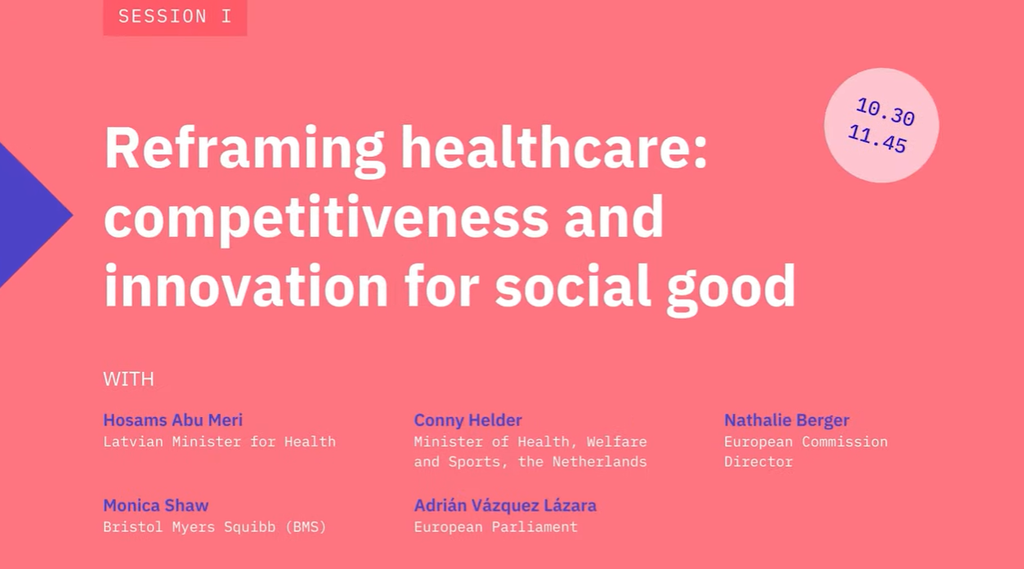Europe's moment: advancing clinical research and health innovation
Next event In person & online

- Area of Expertise
- Sustainable Livelihoods
Sustainable Livelihoods

Head of the Organisation for Economic Co-operation and Development (OECD) Health Division
Europe’s health spending has dropped from the 2000-2009 year-on-year increases of around 5% before to the economic crisis to an average fall of -0.9% in 2010 and -0.4% in 2012. In half of the EU’s 28 countries, health spending has suffered cutbacks, and slowed significantly in the rest. Rising pressure to show real value for money is triggering innovative approaches to health system reform. In Europe, EU institutions are exerting greater influence on these systems, and right across the OECD, governments are searching for new mechanisms offering improved quality and efficiency. Different approaches are in demand to structure public health services, while ways to leverage innovations like big data offer promises to streamline health systems.
Facing up to these new challenges demands some important paradigm shifts. A first one concerns the way health systems will respond to Europe’s ageing population. Today’s health systems are not ready to deal with the rising tide of chronic conditions and specifically what is known in the jargon as “multimorbidity”. This is true for conditions that we understand relatively well, like diabetes or heart disease, and even more so for conditions like dementia, where we are almost entirely without treatment options. We need to get better at managing the impact of ageing, both for individuals, as no two patients are alike, and on systems that are still organised around episodic, curative and acute care needs. On top of that, there is the societal challenge of meeting people’s expectations for equity in ageing.
We have too little information on the outcomes that really matter to people, such as pain or the quality of life after a medical intervention
The fact that we now live longer doesn’t always mean that we live in good health. Today, the average person in an OECD country can expect to live 20 years longer than in 1970; in the EU life expectancy increased by five years between 1990 and 2012. A good proportion of the population can now expect to live in excellent health until over 80. Yet over 60% of people aged between 65 and 74 suffer from at least one chronic condition, and from the age of 75 many have three or more. By 2050, one in ten people in the OECD area will be aged over 80, compared to 4% today.
The growth of multiple chronic conditions poses some very specific challenges. Because very different diseases like diabetes, arthritis and depression can co-exist in the same individual, health services need to be more systematic in the way they engage with patients and their families. Too often, health systems are centred around the provider rather than the patient, and are not responsive enough to an individual’s care needs. Still too few examples of patients being truly involved in decisions about their own care can be found.
Patients who suffer from more than one chronic condition have complex health and social care needs that require regular monitoring by different care professionals and call for complex health and social care packages. This in turn means integrating disease prevention, primary care and hospital care. Health and social care must be better co-ordinated to minimise delay and waste too. Designating primary-care providers as the co-ordinators of these linked-up services will be key to avoid unnecessary and costly hospitalisations.
As well as meeting individual health and social care needs, improved health systems must also meet changing societal obligations. These include helping an ageing population in Europe and elsewhere across the OECD to be economically active; and it also means minimising socio-economic inequalities as they build up throughout an individual life course.
Healthcare systems need to speed up their ability to integrate “network technologies” and new care models
The second paradigm shift has to do with healthcare innovation. Health is sadly the only sector of an economy where new technologies cost more than old ones. OECD calculations suggest that between 1995 and 2009 the increased number of old people in its member countries was responsible for only 12% of all health spending increases, while rising health prices and new technologies have pushed up the bulk of the extra costs. In short, our healthcare innovation model is broken and requires a new set of incentives and arrangements that share risks and rewards better.
In spite of the high and growing cost of health technologies, we are still not getting the kind of innovation that is needed the most. Innovations in the pharmaceutical sector, for example, are mostly not breakthroughs; rather, they are often incremental innovations in low-risk areas that have limited therapeutic added value when compared to alternatives that are already on the market. Important areas that remain unaddressed range from hearing loss to lower back pain to anti-microbial resistance.
Dementia is a compelling illustration of this. Ageing means that the number of people affected by dementia has now reached almost 50 million worldwide. Unfortunately, there has been little scientific progress to date on this devastating disease. Despite the huge market potential, efforts to find a cure for dementia have been hampered by too little potential rewards for companies. Another challenge is posed by high-priced medicines. A case is the arrival on the market of treatments such as for hepatitis C; although extremely effective compared to existing treatments, these treatments also come with very high unit prices that risk busting public budgets.
In both cases, today’s pricing and reimbursement models are called into question. New price incentives that provide the appropriate signals to private sector companies need to be developed. These could include annuity-type payments that would spread the cost of expensive treatments over a period of time, or pay-for-performance value-based pricing that would share the financial risks of a product between those who pay and the healthcare industry on the basis of the outcomes the new drugs bring to patients.
Only half of the 34 countries in the OECD have policies to address how data from electronic health records could be used to inform clinicians, conduct research and improve patient safety
Yet another issue is how best to ensure the spread of healthcare innovations within a system. Many new developments are coming to the market, such as home surveillance systems for the aged, “wandering alarms” for people suffering from dementia and mobile phone apps that can monitor symptoms and clinical data such as heart rates. Healthcare systems need to speed up their ability to integrate “network technologies” and new care models. In general, health systems have a good track record for adopting clinical innovations like new drugs, devices and procedures, but this is far less true of innovations that seek to change communications, informatics or logistics. Too often, promising innovations fail to scale-up because of a lack of system readiness, proof of value or the right incentives.
There is a third paradigm shift that is required, and it is being stimulated by the data revolution. Our societies are increasingly affected by ‘big data’, yet health systems are themselves notoriously poor at generating and using the right data to support clinical decisions or inform policymaking. As a result, important opportunities to strengthen quality and improve efficiencies are being missed.
Health systems’ metrics are often inadequate. Although there have been improvements in measuring patients’ individual experiences and the safety of healthcare services, we have too little information on the outcomes that really matter to people, such as pain or the quality of life after a medical intervention. Despite the volume and variety of biological, administrative, as well as patient-level data that can be extracted from health records, it is still not possible to get a full picture of the quality of the care delivered to patients, especially those with complex needs. Information in many health systems remains fragmented: our failure to glue together different pieces of information means not only poor care quality, but also that healthcare providers continue to be rewarded on the basis of care volume rather than on outcomes.
Addressing all these weaknesses is a must. The potential for using data more effectively is huge, be it reduced medical errors, improved care co-ordination for patients with chronic conditions, and less waste. Strikingly little progress, though, has been made so far. Only half of the 34 countries in the OECD have policies to address how data from electronic health records could be used to inform clinicians, conduct research and improve patient safety. Only half of those countries regularly link existing health data sets to monitor healthcare quality, even though getting a good picture of the care received by patients requires precisely that sharing of medical records. An important point is that this will only be possible in countries where legislation permits the use of personal data in a way that is both respectful of individuals’ right to confidentiality and allows the use of personal health data to make advances in research and care.
Seven years of economic and financial crisis have challenged health systems in significant ways, particularly in Europe. Governments have responded by seeking to protect access to healthcare for the most socially vulnerable, while limiting budgets in the interests of fiscal health. Both are crucial policy reform areas, but there are other pressures on health systems that demand renewed attention. The three paradigm shifts outlined here offer huge opportunities for health systems to deliver greater efficiency and value, and are crucially important to our ageing societies.
Next event In person & online

Past event In person & livestreamed

Past event In person

Past event In person & livestreamed





Stay informed
We use cookies and similar technologies to adjust your preferences, analyze traffic and measure the effectiveness of our campaigns. Learn more about our privacy policy.